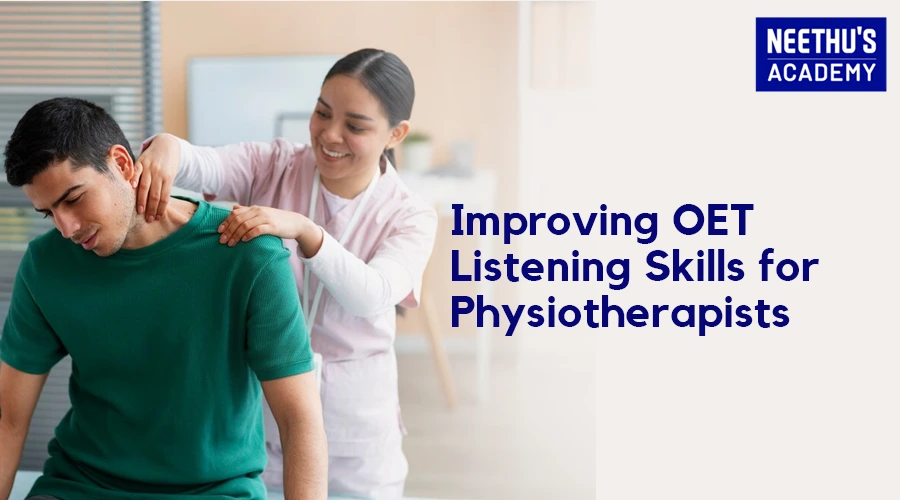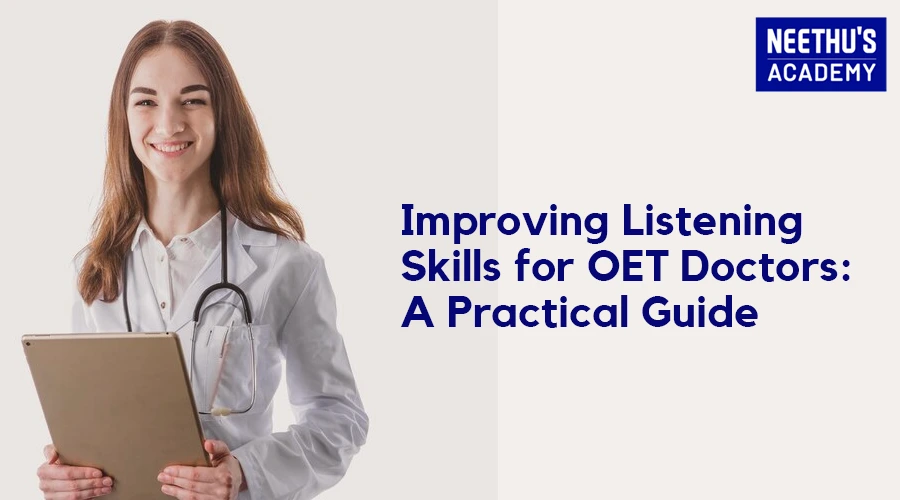Understanding the OET Speaking Scoring Criteria: Key Tips for High Scores
Healthcare workers must sit for the OET Test, as it not only evaluates your language ability but also their capability to communicate effectively in clinical contexts. It is a vital step for healthcare professionals aiming to work in English-speaking countries. Among its four subtests-listening, reading, writing, and speaking; the OET Speaking Test is quite important. To successfully acquire the desired scores, aspiring candidates must understand the scoring criteria of the OET speaking test. In this blog, we will walk you through the score breakdown, key tips for improving your performance, and the common mistakes to avoid, ensuring you achieve your desired score and will be fully prepared for the OET speaking test.
Overview of the OET Speaking Test
The OET Speaking Test consists of two role-play scenarios where the students simulate cases of dealing with patients or caregivers. Each of the role plays lasts for about five to seven minutes and tests the linguistic abilities along with the candidate’s ability to communicate effectively in a medical context. The test has been designed to make it reflect realistic healthcare situations and hence becomes an actual gauge of the readiness of the student to work in a healthcare environment.
Students are given a particular context, role, or patient profile, which they should adopt for that interaction. This format tests the adaptation of different communication styles for the successful management of different patients. Once again, their ability to think on their feet and respond accordingly in a clinical setting will be tested.
Breakdown of the OET Speaking Scoring Criteria
The OET Speaking test is divided into two main categories where one is linguistic criteria and clinical communication criteria. Understanding these will help the candidates focus their preparation efforts effectively.
Linguistic Criteria
Grammar and Vocabulary: The candidate should be able to comprehend complex grammatically constructed sentences, have an appropriate range of vocabulary, and use a mix of common and specialized medical terms. This is essential since it indicates your understanding of healthcare language and practice. Precise vocabulary in place will avoid ambiguity, particularly in patient relations.
Pronunciation: Pronunciation has to be clear so that what the healthcare professional is saying is understood by the patient or colleague. Mispronunciation may cause miscommunication in clinical settings. The candidates have to practice lots of difficult words and phrases presented about their field in order to improve pronunciation skills.
Fluency and Cohesion: Fluency without hesitations and pauses is required while speaking. Fluency of speech refers to smoothness, and coherence refers to the logical flow of ideas and information generated during the interaction. Practicing a few times with a timer can help candidates become better accustomed to speaking under the time constraints of the exam.
Clinical Communication Criteria
Empathy and Rapport: Showing empathy and rapport with patients is required for proper communication. It means you are being attentive and responsive to what a patient wants and needs. You can do this by actuating the ear for active listening, and giving validations on feelings by using phrases such as “I can see why you might feel that way,” and “I understand.”.
Information gathering: Asking the right kinds of questions to gather the right kinds of information is extremely fundamental in proper diagnosis and treatments. Candidates should develop asking open-ended questions to encourage patients to respond with as much detail as possible, thereby learning the patient’s perspective.
Providing Information: The candidate must communicate clearly and effectively to the patient to ensure that they understand their condition and plan of care. Most patients are not aware of the meaning of complex medical terms used, so this has to be explained very clearly. Analogies or examples might have to be given to the patient to understand a complicated explanation.
Tips to Improve your OET Speaking Score
Practice Role-play Scenarios
You can practice role-play scenarios to familiarize yourself with the test format. It can be highly rewarding to simulate real-life interactions with a colleague or mentor. Role-plays might be recorded and taken into consideration for improvements. Practicing in group settings can help you learn from others’ strengths and weaknesses.
Focus on Clarity and Fluency
Your speech should be clear and fluent and avoid mumbling and speaking too fast. Sometimes, it can get annoying when one mumbles and speaks too fast to be understood. A speaker should be able to enunciate clearly and properly, so a listener gets a clear indication of what the speaker wants to say. Reading aloud and practicing on tongue twisters will help a person speak more clearly and fluently.
Using Appropriate Medical Terminology
Using appropriate medical terminology when needed shows your familiarity with the healthcare field. Be sure that you know what you are using and can define it clearly to a patient. Developing a glossary of terms and practicing in context can help you feel even more confident and fluent in medical language.
Record yourself
Recording your practice sessions can be an eye-opening experience. Listening to your recordings allows you to critique your performance, focusing on areas like pronunciation, fluency, and clarity. Consider using a score calculator to assess your performance against OET speaking criteria to identify your strengths and weaknesses.
Common Mistakes to Avoid in OET Speaking
Ignoring the role-play scenario: Let’s not forget the specific requirements for the role-play. Without those, you may end up misunderstanding what is expected of you and score lower marks than expected. Read through the instructions clearly and practice your responses according to the context given.
Using too much jargon: While communicating with the patient, proper medical terminology should be used. However, overloading the speech full of jargon may lead to confusion rather than clarification. Be able to exert a balance between technical terms and layman’s terms to be professional yet clear in your communication with the patient.
Overlooking non-verbal communication: Body language and gaze happen to be significant contributors to communication. Ensure that your nonverbal is in congruence with your verbal; that is, maintain eye contact and use gestures to augment your message. This non-verbal interaction might take you to that stage where you feel you can connect well and build rapport.
Not Soliciting Feedback: Most candidates practice in isolation and miss the opportunities for constructive feedback. Sharing your practice sessions with peers who will provide insights into your performance or mentors who can give the necessary input is priceless. Add them to your practice routine to keep improving.
Conclusion
The more a candidate understands the OET speaking scoring criteria, the more they will be able to perform during their test. By focusing on linguistic and clinical communication criteria, practicing role-play scenarios, and avoiding common mistakes candidates can significantly improve their OET Speaking scores. Good preparation will equip you with the appropriate skills to succeed in the healthcare environment while also improving your confidence level.
Passing the OET Test can open doors to numerous healthcare-related job opportunities and passing the OET Speaking sub-test will enhance your overall score. With the right preparation and mindset candidates can easily navigate the challenges of the test and become successful. Wishing you nothing but luck on your OET journey!
Frequently Asked Questions





